Input interpretation

Na sodium + AgNO_3 silver nitrate ⟶ NaNO_3 sodium nitrate + Ag silver
Balanced equation
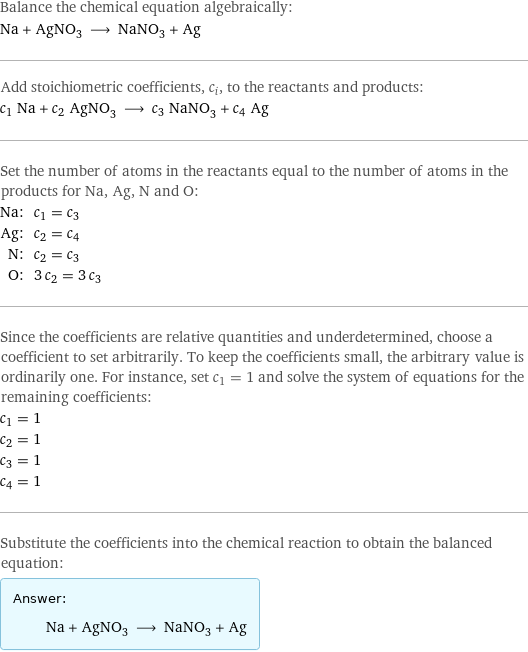
Balance the chemical equation algebraically: Na + AgNO_3 ⟶ NaNO_3 + Ag Add stoichiometric coefficients, c_i, to the reactants and products: c_1 Na + c_2 AgNO_3 ⟶ c_3 NaNO_3 + c_4 Ag Set the number of atoms in the reactants equal to the number of atoms in the products for Na, Ag, N and O: Na: | c_1 = c_3 Ag: | c_2 = c_4 N: | c_2 = c_3 O: | 3 c_2 = 3 c_3 Since the coefficients are relative quantities and underdetermined, choose a coefficient to set arbitrarily. To keep the coefficients small, the arbitrary value is ordinarily one. For instance, set c_1 = 1 and solve the system of equations for the remaining coefficients: c_1 = 1 c_2 = 1 c_3 = 1 c_4 = 1 Substitute the coefficients into the chemical reaction to obtain the balanced equation: Answer: | | Na + AgNO_3 ⟶ NaNO_3 + Ag
Structures
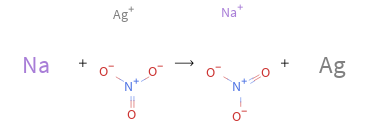
+ ⟶ +
Names

sodium + silver nitrate ⟶ sodium nitrate + silver
Reaction thermodynamics
Enthalpy
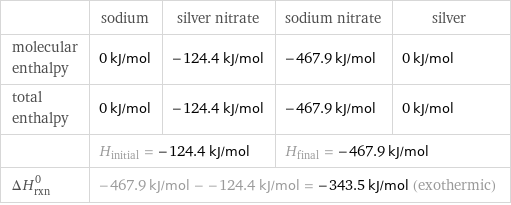
| sodium | silver nitrate | sodium nitrate | silver molecular enthalpy | 0 kJ/mol | -124.4 kJ/mol | -467.9 kJ/mol | 0 kJ/mol total enthalpy | 0 kJ/mol | -124.4 kJ/mol | -467.9 kJ/mol | 0 kJ/mol | H_initial = -124.4 kJ/mol | | H_final = -467.9 kJ/mol | ΔH_rxn^0 | -467.9 kJ/mol - -124.4 kJ/mol = -343.5 kJ/mol (exothermic) | | |
Entropy
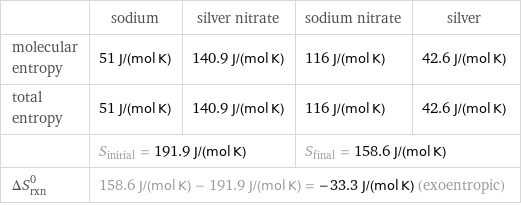
| sodium | silver nitrate | sodium nitrate | silver molecular entropy | 51 J/(mol K) | 140.9 J/(mol K) | 116 J/(mol K) | 42.6 J/(mol K) total entropy | 51 J/(mol K) | 140.9 J/(mol K) | 116 J/(mol K) | 42.6 J/(mol K) | S_initial = 191.9 J/(mol K) | | S_final = 158.6 J/(mol K) | ΔS_rxn^0 | 158.6 J/(mol K) - 191.9 J/(mol K) = -33.3 J/(mol K) (exoentropic) | | |
Equilibrium constant
![Construct the equilibrium constant, K, expression for: Na + AgNO_3 ⟶ NaNO_3 + Ag Plan: • Balance the chemical equation. • Determine the stoichiometric numbers. • Assemble the activity expression for each chemical species. • Use the activity expressions to build the equilibrium constant expression. Write the balanced chemical equation: Na + AgNO_3 ⟶ NaNO_3 + Ag Assign stoichiometric numbers, ν_i, using the stoichiometric coefficients, c_i, from the balanced chemical equation in the following manner: ν_i = -c_i for reactants and ν_i = c_i for products: chemical species | c_i | ν_i Na | 1 | -1 AgNO_3 | 1 | -1 NaNO_3 | 1 | 1 Ag | 1 | 1 Assemble the activity expressions accounting for the state of matter and ν_i: chemical species | c_i | ν_i | activity expression Na | 1 | -1 | ([Na])^(-1) AgNO_3 | 1 | -1 | ([AgNO3])^(-1) NaNO_3 | 1 | 1 | [NaNO3] Ag | 1 | 1 | [Ag] The equilibrium constant symbol in the concentration basis is: K_c Mulitply the activity expressions to arrive at the K_c expression: Answer: | | K_c = ([Na])^(-1) ([AgNO3])^(-1) [NaNO3] [Ag] = ([NaNO3] [Ag])/([Na] [AgNO3])](../image_source/3456cce3b1883e2e7b5a486f0db4dcc5.png)
Construct the equilibrium constant, K, expression for: Na + AgNO_3 ⟶ NaNO_3 + Ag Plan: • Balance the chemical equation. • Determine the stoichiometric numbers. • Assemble the activity expression for each chemical species. • Use the activity expressions to build the equilibrium constant expression. Write the balanced chemical equation: Na + AgNO_3 ⟶ NaNO_3 + Ag Assign stoichiometric numbers, ν_i, using the stoichiometric coefficients, c_i, from the balanced chemical equation in the following manner: ν_i = -c_i for reactants and ν_i = c_i for products: chemical species | c_i | ν_i Na | 1 | -1 AgNO_3 | 1 | -1 NaNO_3 | 1 | 1 Ag | 1 | 1 Assemble the activity expressions accounting for the state of matter and ν_i: chemical species | c_i | ν_i | activity expression Na | 1 | -1 | ([Na])^(-1) AgNO_3 | 1 | -1 | ([AgNO3])^(-1) NaNO_3 | 1 | 1 | [NaNO3] Ag | 1 | 1 | [Ag] The equilibrium constant symbol in the concentration basis is: K_c Mulitply the activity expressions to arrive at the K_c expression: Answer: | | K_c = ([Na])^(-1) ([AgNO3])^(-1) [NaNO3] [Ag] = ([NaNO3] [Ag])/([Na] [AgNO3])
Rate of reaction
![Construct the rate of reaction expression for: Na + AgNO_3 ⟶ NaNO_3 + Ag Plan: • Balance the chemical equation. • Determine the stoichiometric numbers. • Assemble the rate term for each chemical species. • Write the rate of reaction expression. Write the balanced chemical equation: Na + AgNO_3 ⟶ NaNO_3 + Ag Assign stoichiometric numbers, ν_i, using the stoichiometric coefficients, c_i, from the balanced chemical equation in the following manner: ν_i = -c_i for reactants and ν_i = c_i for products: chemical species | c_i | ν_i Na | 1 | -1 AgNO_3 | 1 | -1 NaNO_3 | 1 | 1 Ag | 1 | 1 The rate term for each chemical species, B_i, is 1/ν_i(Δ[B_i])/(Δt) where [B_i] is the amount concentration and t is time: chemical species | c_i | ν_i | rate term Na | 1 | -1 | -(Δ[Na])/(Δt) AgNO_3 | 1 | -1 | -(Δ[AgNO3])/(Δt) NaNO_3 | 1 | 1 | (Δ[NaNO3])/(Δt) Ag | 1 | 1 | (Δ[Ag])/(Δt) (for infinitesimal rate of change, replace Δ with d) Set the rate terms equal to each other to arrive at the rate expression: Answer: | | rate = -(Δ[Na])/(Δt) = -(Δ[AgNO3])/(Δt) = (Δ[NaNO3])/(Δt) = (Δ[Ag])/(Δt) (assuming constant volume and no accumulation of intermediates or side products)](../image_source/a1d5a6fb3b13f70179083f7686ba5a4f.png)
Construct the rate of reaction expression for: Na + AgNO_3 ⟶ NaNO_3 + Ag Plan: • Balance the chemical equation. • Determine the stoichiometric numbers. • Assemble the rate term for each chemical species. • Write the rate of reaction expression. Write the balanced chemical equation: Na + AgNO_3 ⟶ NaNO_3 + Ag Assign stoichiometric numbers, ν_i, using the stoichiometric coefficients, c_i, from the balanced chemical equation in the following manner: ν_i = -c_i for reactants and ν_i = c_i for products: chemical species | c_i | ν_i Na | 1 | -1 AgNO_3 | 1 | -1 NaNO_3 | 1 | 1 Ag | 1 | 1 The rate term for each chemical species, B_i, is 1/ν_i(Δ[B_i])/(Δt) where [B_i] is the amount concentration and t is time: chemical species | c_i | ν_i | rate term Na | 1 | -1 | -(Δ[Na])/(Δt) AgNO_3 | 1 | -1 | -(Δ[AgNO3])/(Δt) NaNO_3 | 1 | 1 | (Δ[NaNO3])/(Δt) Ag | 1 | 1 | (Δ[Ag])/(Δt) (for infinitesimal rate of change, replace Δ with d) Set the rate terms equal to each other to arrive at the rate expression: Answer: | | rate = -(Δ[Na])/(Δt) = -(Δ[AgNO3])/(Δt) = (Δ[NaNO3])/(Δt) = (Δ[Ag])/(Δt) (assuming constant volume and no accumulation of intermediates or side products)
Chemical names and formulas

| sodium | silver nitrate | sodium nitrate | silver formula | Na | AgNO_3 | NaNO_3 | Ag Hill formula | Na | AgNO_3 | NNaO_3 | Ag name | sodium | silver nitrate | sodium nitrate | silver
Substance properties
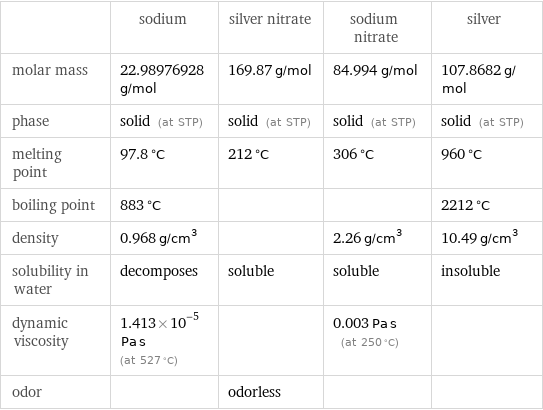
| sodium | silver nitrate | sodium nitrate | silver molar mass | 22.98976928 g/mol | 169.87 g/mol | 84.994 g/mol | 107.8682 g/mol phase | solid (at STP) | solid (at STP) | solid (at STP) | solid (at STP) melting point | 97.8 °C | 212 °C | 306 °C | 960 °C boiling point | 883 °C | | | 2212 °C density | 0.968 g/cm^3 | | 2.26 g/cm^3 | 10.49 g/cm^3 solubility in water | decomposes | soluble | soluble | insoluble dynamic viscosity | 1.413×10^-5 Pa s (at 527 °C) | | 0.003 Pa s (at 250 °C) | odor | | odorless | |
Units
